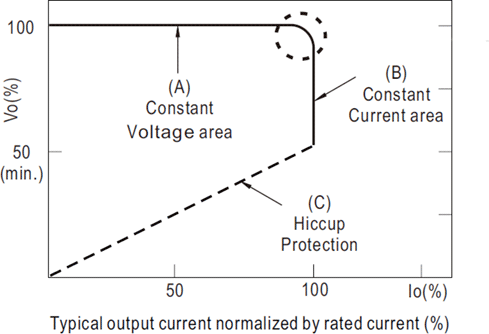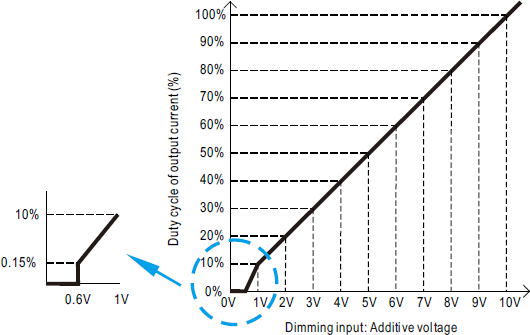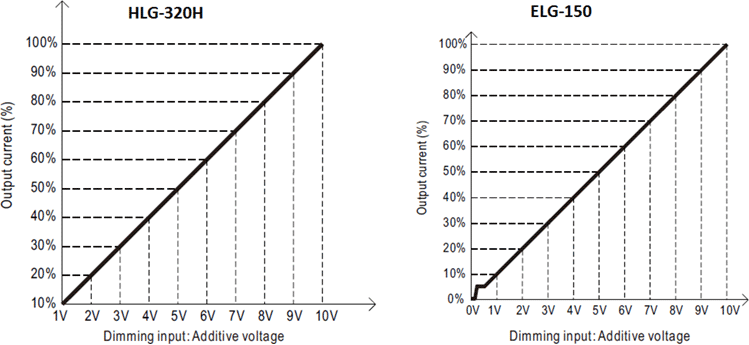Как работает встроенный диммер в блоках питания светодиодных серий MEAN WELL
Одной из ключевых потребностей в современных системах освещения является возможность простого и эффективного управления яркостью, или диммирование (от англ. dimming – затемнение). В системах светодиодного освещения управление яркостью может осуществляться с помощью отдельного устройства – диммера, который подключается между источником питания и непосредственно светодиодным светильником, но более эффективно функция управления яркостью реализуется за счет встроенной в блок питания системы диммирования.
В отличие от внешних диммеров сторонних производителей, где изменяемым параметром является уровень выходного напряжения (меняется с помощью широтно-импульсной модуляции ШИМ), в блоках питания MEAN WELL со встроенным диммером, изменяемым параметром является выходной ток! В этом случае КПД источника питания остается очень высоким, и «ненужная» энергия не рассеивается в виде тепла, а ее потребляется ровно столько, сколько требуется для обеспечения заданного уровня яркости. То есть, блок питания MEAN WELL со встроенным диммером подстраивается под требуемый уровень мощности нагрузки. Полностью график режимов работы блоков питания для светодиодного освещения MEAN WELL представлен на графике (на примере серии ELG-150):
 График режимов работы и изменения выходных параметров на примере серии ELG-150
График режимов работы и изменения выходных параметров на примере серии ELG-150
По умолчанию, блок питания работает в режиме стабилизации напряжения (область Constant Voltage area (A) на графике) с номинальным уровнем напряжения источника питания и уровнем тока, определяемой светодиодной лентой или светильником. В случае 90-100% нагрузки рабочая точка выходной мощности находится в области выделенной курсивом. Управление яркостью с помощью встроенного диммера фактически «сдвигает» границу Constant Current area (B) влево-вправо – от 100% до 0% (или 10% в зависимости от серии блока питания) выходного тока и обратно. Уровень выходного напряжения при этом остается на уровне 100% (например, 24В для ELG-75-24B), то есть рабочая точка выходной мощности перемещается по горизонтальной прямой Constant Voltage area (A).
Если по какой-либо причине мощность нагрузки возрастает (или это изначально LED со стабилизацией по току, например, светодиодные модули или отдельные светодиоды), то блок питания переходит в режим работы CC (constant current) и уровень выходного напряжения может снижаться с номинальных 100% до 50% при максимальном токе, то есть рабочая точка «двигается» по вертикали отрезка B на графике. Если этого снижения (ограничения) выходной мощности окажется недостаточно и нагрузка будет «требовать» мощность больше, то блок питания уйдет в защиту и будет периодически включаться и выключаться (с небольшим периодом, несколько секунд) – это отрезок Hiccup Protection (С). Фактически это режим защиты блока питания от перегрузки.
Таким образом, можно сформулировать рекомендацию, что мощность диммируемого источника питания MEAN WELL должна быть примерна равна (иметь небольшой запас 5-10%) мощности светодиодного светильника или ленты – только в этом случае диммирование будет происходить в полном диапазоне выходной мощности. Например, если к HLG-320H-24B с максимальным выходным током 13.34А подключить стандартную светодиодную ленту 24В мощностью 14.4Вт/м длиной 5м (ток нагрузки составит всего 14.4Вт·5м/24В = 3А), то регулировка яркости этой ленты будет только в диапазоне 0 – 22% выходной мощности блока. Иными словами, большую часть регулировки яркости лента будет светить на полную яркость, и только в конце регулировки – будет очень быстро гаснуть. А если нагрузка будет еще меньше, то регулировка яркости станет практически не заметна, и диммер будет работать просто как переключатель с максимальной яркости на минимальную и обратно.
Отдельно стоит отметить особенность работы встроенного диммера в блоках питания серий PWM. Блоки питания этих серий имеют отдельный модуль широтно-импульсной модуляции выходного тока, который с помощью ШИМ управления позволяет иметь более глубокую настройку уровня выходного тока и, соответственно, яркости (на примере серии PWM-90):
 Принцип формирования выходного тока в блоках питания серии PWM-90
Принцип формирования выходного тока в блоках питания серии PWM-90
Визуально такие пульсации выходного тока за счет выбранной частоты модуляции человеческим глазом видны не будут, но следует иметь в виду эту особенность при применении блоков питания серий PWM в сельском хозяйстве и местах размещения животных (фермы, зоохозяйства, ветеринарные учреждения и др) – такие пульсации могут негативно сказываться на поведении животных.
При этом в блоках питания серий PWM достигается наибольшая глубина регулировка яркости светодиодного светильника или ленты – минимальный порог составляет всего 0.15-0.2% (в зависимости от типа управления диммеров) в отличие от 6-10% порога минимальной яркости для других серий.
 Глубина регулировка выходного тока в блоках питания серии PWM-60
Глубина регулировка выходного тока в блоках питания серии PWM-60
Для сравнения глубина регулировки выходного тока на примерах HLG-320H с минимальным уровнем выходного тока 10%, и ELG-150 с минимальным уровнем выходного тока 8% и затем полным выключением:
 Глубина регулировки выходного тока в блоках питания серий HLG-320H и ELG-150
Глубина регулировки выходного тока в блоках питания серий HLG-320H и ELG-150
Для консультирования или уточнения информации по источникам питания MEAN WELL обращайтесь по адресу электронной почты Meanwell@chipdip.ru.
